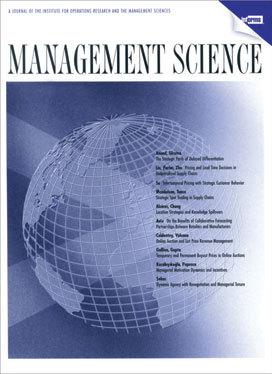Academic articles
Practitioner articles
Working papers
Books
Book chapters
Case studies
Other publications
Subject(s)
Economics, politics and business environment
Keyword(s)
diffusion, information technology, retail competition
JEL Code(s)
L5, L81, O33
Volume
43
Journal Pages
1737–1748
Subject(s)
Strategy and general management
Volume
4
Journal Pages
34–36
Subject(s)
Human resources management/organizational behavior
Keyword(s)
careers, career entrepreneurship, career coaching, career management
This article introduces "career entrepreneurship," a rapidly spreading phenomenon in the global knowledge-driven economy. Career entrepreneurship involves taking an entrepreneurial approach to managing our careers. It means doing things that seem "illegitimate" to other people and contradict socially-recognized and accepted sequences of work experiences in terms of age, education, or socio-economic progression. This kind of behavior challenges established norms about typical career development. The evidence presented in this article suggests new possibilities for thinking about the way individuals invest in their careers, new insights for organizations interested in capturing the potential of career entrepreneurship, and new ideas for career and life coaches to support people embracing the phenomenon. The article offers a primer on career entrepreneurship to all three groups of readers, calling for more effective collaborative relationships and more effective leveraging of individuals' career investments.
With permission of Elsevier
Volume
40
Journal Pages
127–135
Subject(s)
Technology, R&D management
Keyword(s)
patenting, patent thickets, patent portfolio races, complexity
JEL Code(s)
L13, L20, O34
The existing literature identifies patent thickets indirectly. In this paper we propose a novel measure based on patent citations which allows us to measure the density of patent thickets directly. We discuss the algorithm which generates the measure and present descriptive results validating it. Moreover, we identify technology areas which are particularly impacted by patent thickets.
With permission of Elsevier
Volume
111
Journal Pages
6–9
Subject(s)
Economics, politics and business environment
Keyword(s)
markets, other-regarding preferences, self-interest, welfare theorems
JEL Code(s)
D50, D62, D64
We study competitive market outcomes in economies where agents have other-regarding preferences (ORPs). We identify a separability condition on monotone preferences that is necessary and sufficient for one's own demand to be independent of the allocations and characteristics of other agents in the economy. Given separability, it is impossible to identify ORPs from market behaviour: agents behave as if they had classical preferences that depend only on own consumption in competitive equilibrium. If preferences, in addition, depend only on the final allocation of consumption in society, the Second Welfare Theorem holds as long as any increase in resources can be distributed in a way that makes all agents better off. The First Welfare Theorem generally does not hold. Allowing agents to care about their own consumption and the distribution of consumption possibilities in the economy, the competitive equilibria are efficient given prices if and only if there is no Pareto-improving redistribution of income.
© The Author 2011. Published by Oxford University Press on behalf of The Review of Economic Studies Limited.
Volume
78
Journal Pages
613–639
Subject(s)
Strategy and general management
Keyword(s)
competitive strategy, competitive advantage, madonna, customer analysis
The business world has a healthy appetite for learning from unusual role models. In this article from the 2006 archives, Jamie Anderson, Martin Kupp and Jorg Reckhenrich reveal the entrepreneurial side of an entertainment legend.
© 2011 London Business School
Volume
22
Journal Pages
65–68
Subject(s)
Economics, politics and business environment
Keyword(s)
Regulation, competition, telecommunications, broadband, strategic investment
JEL Code(s)
L51, L96, L10, K23
This paper analyses how different types of access regulation to next generation networks affect investments and consumer welfare. The model consists of an investment stage with uncertain returns and subsequent quantity competition. The access price is a function of investment costs and the regulatory regime. A regime with fully distributed costs or a regulatory holiday induces highest investments, followed by risk-sharing and long run incremental costs regulation. Simulations indicate that risk-sharing creates most consumer welfare, followed by regimes with fully distributed costs, regulatory holiday and long run incremental costs, respectively. Risk-sharing benefits consumers as it combines relatively high ex-ante investment incentives with strong ex-post competitive intensity.
Volume
29
Journal Pages
263–272
Subject(s)
Strategy and general management
Keyword(s)
networks, graphs, theory, organizational studies, design, effectiveness, performance, status, leadership
What is the best way to design tournaments for status, in which individuals labor primarily for the esteem of their peers? What process, in other words, should organizers of status-based contests impose upon those who covet peer recognition? We propose a formal model of status-based competition that contrasts two competing alternatives. The first, following Merton, is the "Matthew Effect," according to which a tournament's architect directs slack resources to elite actors and thus widens the distribution of rewards by favoring cumulative advantage. The second is the "Mark Effect," under which a tournament's designer instead pushes slack resources to marginal actors and thus tightens the distribution of rewards. Our results suggest that although the Mark Effect is better for the social welfare of most tournaments, the Matthew Effect is preferable in two distinct contexts: in small tournaments where variation in underlying ability translates into acute advantages for the most capable contestants; and in large tournaments whose contestants face constant, rather than rising, marginal costs-a condition we relate to contestants' perception of their work as intrinsically valuable. Our contributions are twofold: We find, counter to the thrust of Merton's work, that cumulative advantage is not invariably optimal for the functioning of status contests; and we identify circumstances in which the production of superstars is likely to make contests for status better off in aggregate. Implications for future research on status and management are discussed.
© 2011 INFORMS
Volume
57
Journal Pages
439–457
ISSN (Online)
1526-5501
ISSN (Print)
0025–1909
Subject(s)
Ethics and social responsibility; Marketing
Keyword(s)
societal welfare, stakeholder welfare, social responsibility, consumption, volunteerism, price, direct advertising
We discuss the reasons why this call for papers was issued and describe the process of selecting the three articles presented in this special section. We argue that maximizing stakeholder welfare and not just consumption maybe a new goal for marketing that will be consistent with emerging societal trends. Three articles on volunteerism, price assurances, and direct-to-consumer advertising result from our call and are presented in this section. This introduction is an overview of the three articles.
With permission of Elsevier
Volume
64
Journal Pages
59–60
Subject(s)
Economics, politics and business environment
Keyword(s)
consumer, contracts, regulation, consumer protection
JEL Code(s)
D14, D18, D49, D86
We analyze contract choices, loan-repayment behavior, and welfare in a model of a competitive credit market when borrowers have a taste for immediate gratification. Consistent with many credit cards and subprime mortgages, for most types of nonsophisticated borrowers the baseline repayment terms are cheap, but they are also inefficiently front loaded and delays require paying large penalties. Although credit is for future consumption, nonsophisticated consumers overborrow, pay the penalties, and back load repayment, suffering large welfare losses. Prohibiting large penalties for deferring small amounts of repayment-akin to recent regulations in the US credit-card and mortgage markets-can raise welfare.
Copyright © 2012 by the American Economic Association.
Volume
100
Journal Pages
2279–2303

